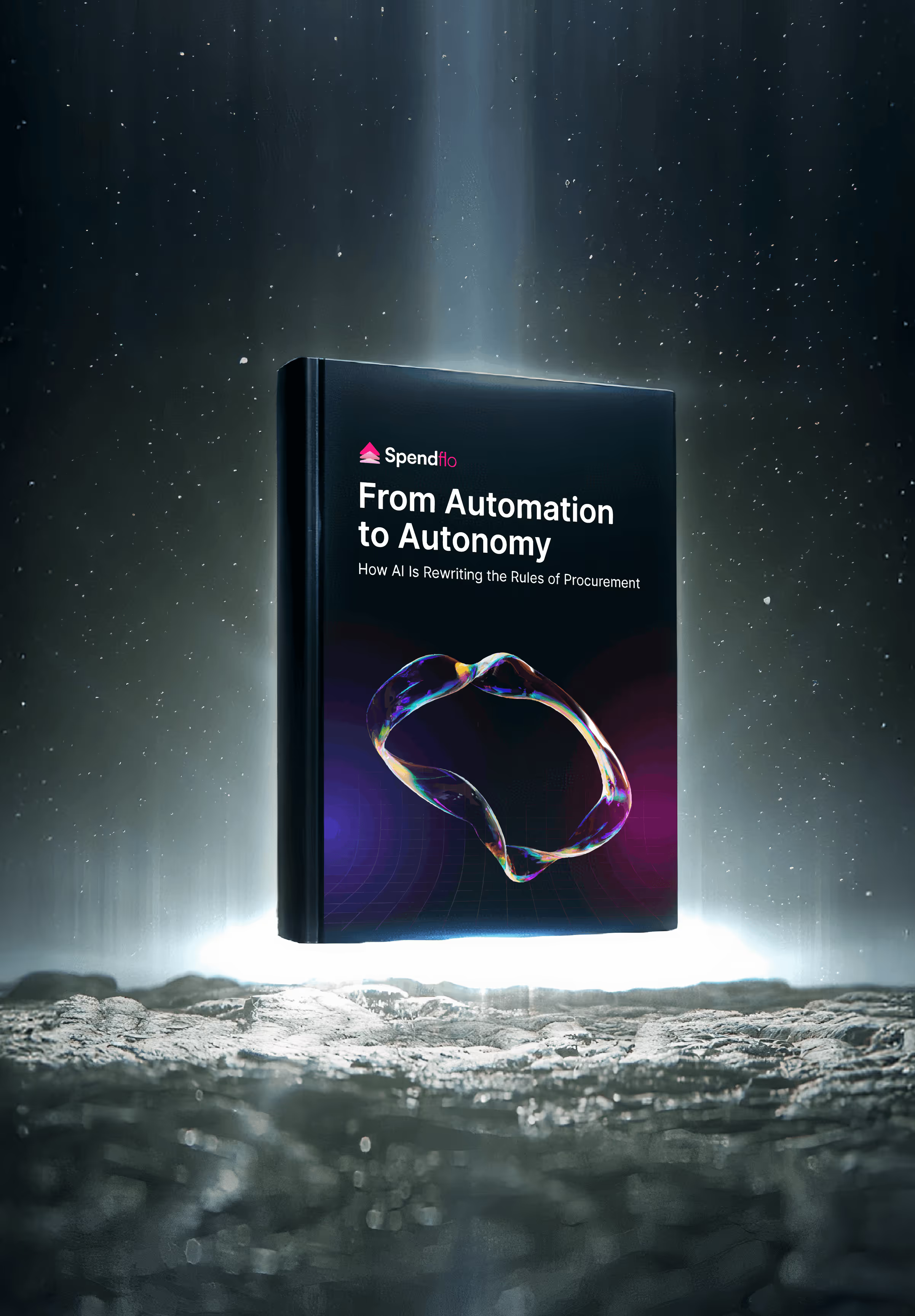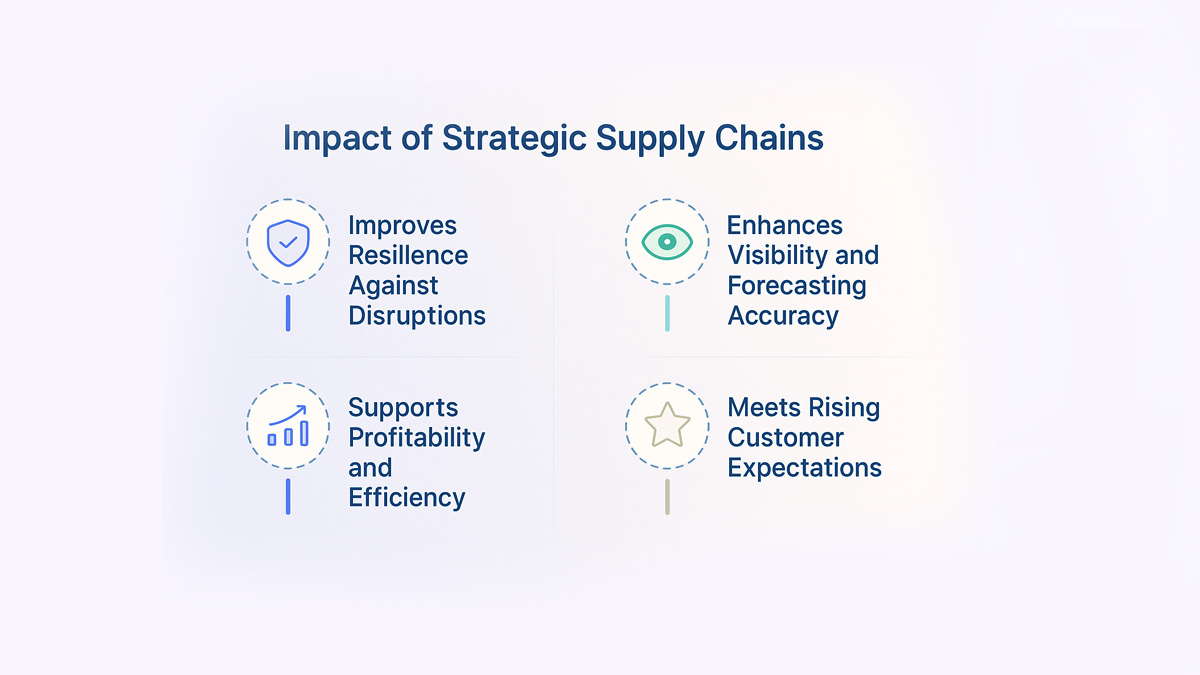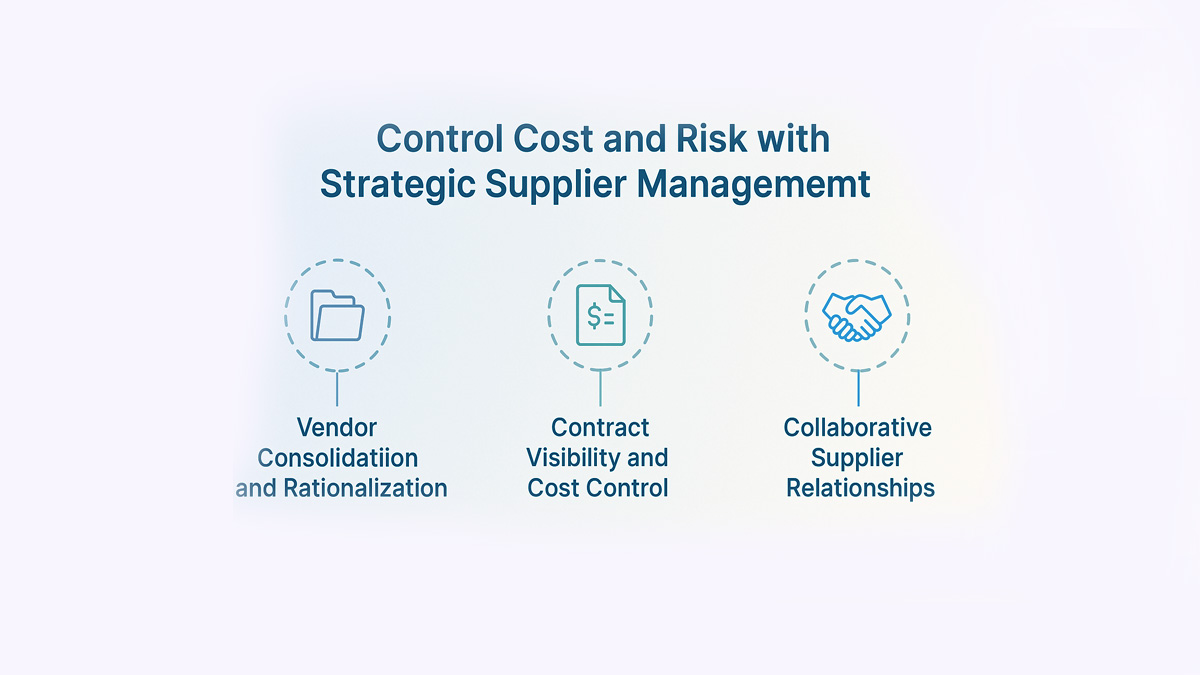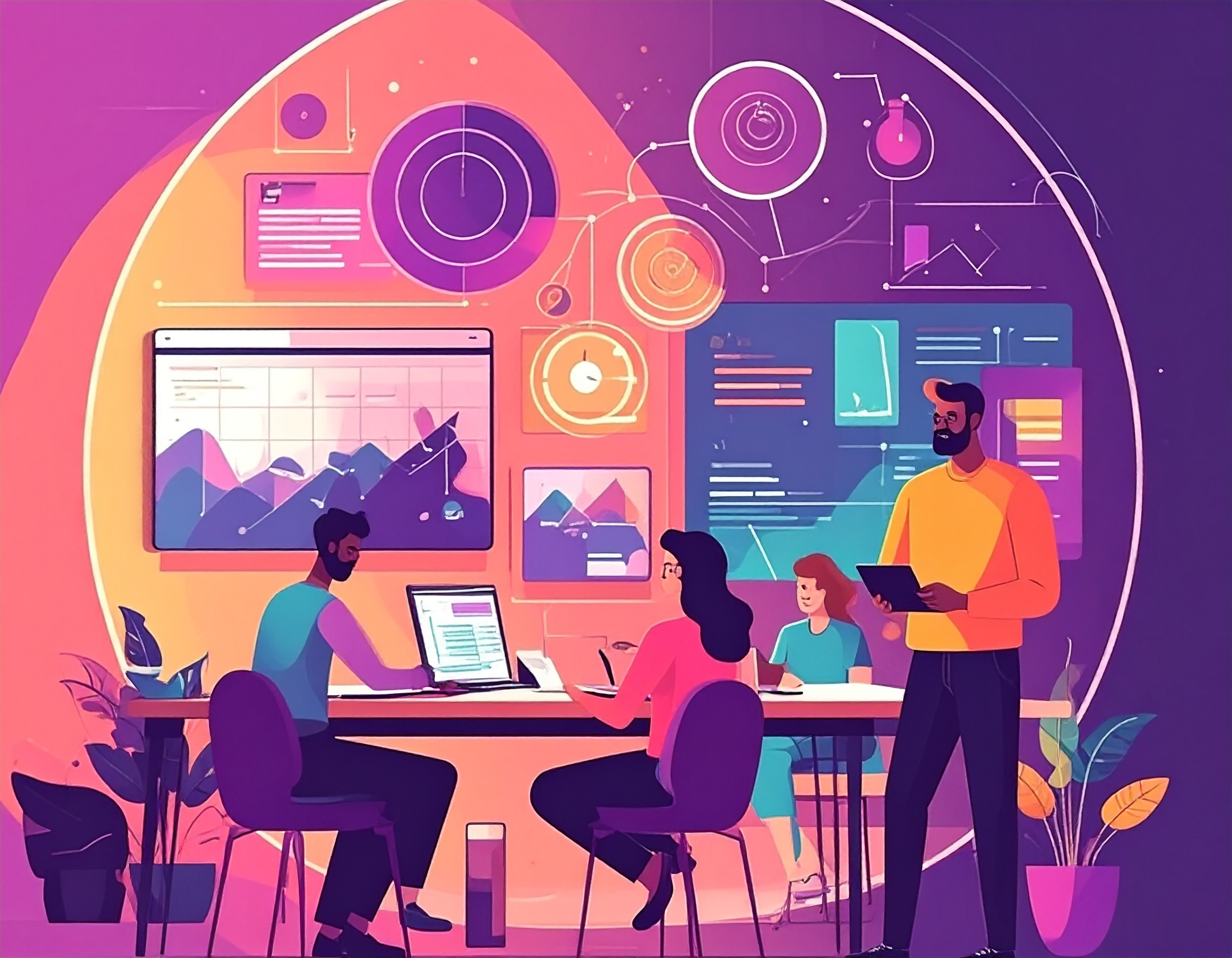

Top Supply Chain Management Strategies to Optimize Operations in 2025

Top Supply Chain Management Strategies to Optimize Operations in 2025
Discover top supply chain strategies for 2025 to improve visibility, reduce costs, and build resilient, data-driven operations.


In today’s volatile global environment, global supply chains face more pressure than ever before. Disruptions caused by geopolitical shifts, raw material shortages, and extreme weather events are forcing organizations to rethink how they manage their suppliers, inventory, and distribution networks. Simply reacting to issues is no longer enough. Proactive, data-led, and resilient supply chain management strategies are the key to staying competitive.
What this blog covers:
- What are supply chain management strategies?
- Why strategic supply chains matter more than ever
- Top supply chain optimization strategies for 2025
- Building agility: best practices for resilient operations
- Reducing cost and risk through strategic supplier management
- How technology is transforming supply chain decision-making
- Data-led strategies to improve procurement and fulfillment
- How Spendflo helps with supply chain strategy optimization
- Frequently asked questions on supply chain management strategies
What Are Supply Chain Management Strategies?
Supply chain management strategies are structured plans and practices that businesses use to streamline the flow of goods, services, and information - from raw materials to final delivery. These strategies aim to improve efficiency, reduce costs, and ensure resilience across procurement, logistics, and fulfillment.
Why Strategic Supply Chains Matter More Than Ever
Modern supply chains are no longer just operational backbones - they are strategic drivers of business success. In a landscape shaped by global uncertainties, companies must go beyond transactional procurement and adopt a long-term, strategic approach to supply chain management. Here’s why:

Improves Resilience Against Disruptions
From geopolitical shifts to natural disasters, unexpected events are now regular occurrences. A strategic supply chain enables companies to adapt quickly by diversifying suppliers, maintaining safety stock, and planning for contingencies. This agility - backed by well-defined contingency plans - helps reduce downtime and maintain service continuity.
Enhances Visibility and Forecasting Accuracy
End-to-end visibility across suppliers, inventory, logistics, and fulfillment is critical for real-time decision-making. With advanced forecasting tools and predictive analytics, businesses can anticipate demand, optimize procurement, and mitigate potential bottlenecks before they escalate.
Supports Profitability and Efficiency
Strategic supply chain strategies reduce waste, improve demand planning, and eliminate unnecessary costs - leading directly to better margins. Whether through supplier negotiation or logistics optimization, well-executed supply chains help protect the bottom line while enhancing overall operational efficiency.
Meets Rising Customer Expectations
Today’s customers expect fast, accurate, and transparent service. Delays, shortages, or poor communication can negatively impact customer service and erode loyalty. A customer-centric supply chain strategy ensures timely delivery, consistent product quality, and real-time updates - directly impacting the overall customer experience.
By focusing on long-term value instead of short-term cost savings, companies can turn their supply chain from a cost center into a source of competitive advantage.
Top Supply Chain Optimization Strategies for 2025
As global challenges continue to evolve, supply chains must become smarter, faster, and more adaptable. Optimization in 2025 isn’t just about reducing costs - it’s about building systems that thrive under pressure while delivering consistent value. Below are the top strategies forward-thinking organizations are prioritizing:
Predictive Analytics and Demand Planning
Forecasting demand with precision is no longer optional. Predictive analytics uses historical data, market trends, and even weather patterns to anticipate demand fluctuations. This helps procurement teams order the right quantities at the right time, reducing both stockouts and overstocking. Advanced demand planning tools enable businesses to respond to changes in real time, boosting responsiveness and minimizing waste.
Strengthening Supplier Relationship Management (SRM)
Strong supplier relationships are critical to operational continuity. SRM tools help manage performance, ensure contract compliance, and encourage collaboration. Organizations that treat suppliers as strategic partners - not just vendors - are more likely to secure favorable pricing, early access to inventory, and priority during disruptions. Effective SRM also supports innovation and joint problem-solving.
Inventory Optimization and Safety Stock Planning
Inventory optimization ensures you have what you need - without tying up unnecessary capital. Companies are turning to AI-driven inventory management solutions that analyze sales trends, lead times, and usage patterns to maintain optimal stock levels. Maintaining a calculated amount of safety stock is equally important, especially in industries vulnerable to raw material shortages or supply delays.
Integrated Logistics and Distribution Efficiency
Logistics and distribution are ripe for optimization through route planning tools, automated warehousing systems, and advanced shipment tracking. Integrated logistics platforms allow better coordination across shipping partners, and the distribution center, reducing delays and improving customer delivery timelines. Real-time tracking also offers transparency to customers and internal teams alike.
Sustainability and ESG Integration
Sustainability is no longer a nice-to-have - it’s becoming a competitive imperative. Businesses are embedding environmental, social, and governance (ESG) goals into their supply chain strategy. This includes choosing eco-friendly suppliers, optimizing routes for lower emissions, and investing in recyclable packaging. Consumers and investors alike are rewarding companies that prioritize ESG.
These strategies, when executed together, create a resilient, efficient, and future-ready supply chain. Companies that invest in optimization now will be better prepared for tomorrow’s uncertainties - and more aligned with customer, regulatory, and market expectations.
Building Agility: Best Practices for Resilient Operations
Agility in supply chain operations means more than just reacting quickly - it’s about building systems that can adapt, pivot, and recover fast when faced with disruptions. With continuous risks from extreme weather, global conflicts, with disruptions. With continuous risks from extreme weather, global conflicts, and shifting market demands, resilience has become a core performance metric. Here’s how leading companies are building agility into their supply chains:
Diversifying the Supplier Base
Relying on a single vendor or region for critical components creates vulnerability. To reduce the risk of supply chain disruption, businesses are expanding their supplier networks across different geographies. This not only safeguards against geopolitical and environmental risks but also fosters competition and improves pricing leverage.
Implementing Flexible Procurement Processes
Rigid procurement policies slow down decision-making. Companies are investing in tools and workflows that allow for quick purchase approvals, fast vendor onboarding, and automated compliance checks. Flexibility in procurement ensures that teams can respond rapidly when timelines or supply conditions change.
Scenario Planning and Contingency Modeling
Predictive models and scenario planning tools enable organizations to prepare for "what if" situations - such as raw material shortages or transportation strikes. By simulating disruptions and stress-testing the supply chain, teams can identify supply chain risks and pre-plan responses that minimize downtime.
Agile supply chains aren't just more resilient - they give every supply chain manager a competitive edge in responding to uncertainty. By designing for adaptability, companies position themselves to serve customers faster, recover from shocks efficiently, and seize new opportunities as they arise.
Reducing Cost and Risk Through Strategic Supplier Management
Supplier management isn’t just about getting the lowest price - it’s about building reliable, transparent, and strategic relationships that reduce long-term costs and risk exposure. In 2025, successful procurement teams are rethinking their approach to supplier partnerships with a focus on control, collaboration, and continuity.

Vendor Consolidation and Rationalization
Too many vendors can create unnecessary complexity, administrative burden, and hidden costs. By consolidating suppliers and focusing on high-performing, strategically aligned partners, companies can negotiate better rates, streamline contract management, and improve service levels. A leaner supplier base also allows procurement teams to monitor performance and compliance more closely.
Contract Visibility and Cost Control
Without centralized visibility into supplier contracts, businesses often face missed renewal deadlines, unoptimized pricing, and overlapping services. Digital supplier management platforms help teams stay ahead of renewals, renegotiate terms proactively, and align contracts with actual usage data. Better visibility leads to smarter decisions and cost-saving opportunities.
Collaborative Supplier Relationships
Strategic suppliers can become true partners in innovation, risk-sharing, and joint problem-solving. Engaging in regular performance reviews, co-developing solutions, and sharing forecasts helps both sides succeed. Collaborative relationships also improve supply continuity during disruptions, as suppliers prioritize businesses they see as long-term partners.
A modern supplier strategy isn’t just reactive - it’s a proactive, risk management approach to building a smarter, more stable supply chain. When companies manage suppliers strategically, they unlock both resilience and cost efficiency.
How Technology Is Transforming Supply Chain Decision-Making
Technology is no longer just an enabler in supply chains - it’s the central nervous system. In 2025, supply chain leaders are leveraging digital tools not just to automate tasks, but to guide smarter, faster, and more strategic decisions at every level of operations.
Digital Dashboards and Real-Time Data
Modern supply chain platforms offer centralized dashboards that give teams real-time supply chain visibility across procurement, logistics, and fulfillment. With live updates on order status, supplier performance, and inventory levels, decision-makers can identify risks early and act swiftly. This level of transparency reduces guesswork and keeps operations aligned with business goals.
AI, IoT, and Automation in Logistics
Artificial intelligence and the Internet of Things (IoT) are changing how goods move and how teams respond. AI can enhance demand forecasting accuracy, optimize delivery routes, and detect inefficiencies before they become costly. Meanwhile, IoT-enabled sensors in warehouses and transportation networks offer instant insights into stock conditions, temperature control, and delivery timelines - ensuring better quality control and faster interventions.
Cloud-Based Procurement Tools
Cloud solutions and enterprise resource planning systems enable distributed procurement teams to collaborate in real time, access shared data, and standardize processes across locations. These tools also support digital contract management, automated approvals, and spend analysis - all of which reduce procurement cycle time and improve supplier compliance.
Technology is turning supply chains into dynamic, responsive ecosystems. Businesses that embrace these digital capabilities are better equipped to anticipate changes, reduce costs, and deliver on customer expectations - no matter the circumstances.
Data-Led Strategies to Improve Procurement and Fulfillment
In 2025, supply chains are only as strong as the data behind them. The most efficient organizations are those that use data not just for reporting - but as a driver of action. A data-driven approach helps procurement teams align strategy with real-time insights, make informed decisions faster, and deliver more value across the fulfillment process.
Using Procurement Analytics for Better Decisions
Modern procurement platforms provide analytics that go beyond spend tracking. With detailed dashboards, teams can analyze vendor performance, compare contract terms, evaluate pricing trends, and identify saving opportunities. These insights make it easier to prioritize high-performing suppliers, renegotiate outdated contracts, and eliminate underused tools or services.
Aligning Spend Data with Supply Planning
Procurement and supply chain planning often operate in silos, leading to mismatched inventory levels or budget overruns. A unified data model allows procurement teams to tie supplier decisions directly to forecasted demand and stock levels. This ensures that purchases are both timely and cost-effective, supporting more accurate production planning and helping avoid overbuying or stockouts.
Centralizing Supplier and Inventory Data
Centralizing supplier information, contract history, and inventory movement gives procurement and fulfillment teams a shared source of truth. This reduces manual errors, speeds up order cycles, and simplifies compliance checks. With real-time access to these insights, teams can track every touchpoint - from requisition to delivery - more efficiently.
A data-led approach, removes guesswork from procurement and fulfillment. Instead of reacting to issues, teams can prevent them, optimize performance, and adapt quickly to market changes. The result? Lower costs, faster fulfillment, and a supply chain that supports growth rather than slowing it down.
How Spendflo Helps with Supply Chain Strategy Optimization
Spendflo empowers procurement teams to take control of their SaaS and supplier ecosystems with centralized visibility, intelligent workflows, and expert negotiation support. By streamlining vendor management, automating renewals, and aligning spend with usage, Spendflo helps companies build more resilient and cost-efficient supply chains.
Our platform enables data-driven decisions across the procurement lifecycle - helping businesses optimize supplier performance, cut redundant software, and avoid overspending. With Spendflo, your procurement strategy isn’t just optimized - it’s future-ready.
Frequently Asked Questions on Supply Chain Management Strategies
What are the key goals of supply chain management strategies?
The primary goals are to improve operational efficiency, reduce costs, manage risks, and enhance customer satisfaction. These strategies help businesses ensure timely delivery, optimize inventory, and build resilient supplier relationships.
How do predictive analytics improve supply chain performance?
Predictive analytics use historical and real-time data to forecast demand, detect potential risks, and optimize procurement decisions. This reduces uncertainty, enhances planning accuracy, and improves responsiveness to market changes.
Why is supplier relationship management important?
Strong supplier relationships lead to better pricing, faster problem resolution, and improved delivery reliability. SRM tools help manage contracts, monitor performance, and foster long-term partnerships that drive value.
What role does technology play in supply chain optimization?
Technology enables automation, real-time visibility, and smarter decision-making. Tools like AI, IoT, and cloud-based platforms streamline procurement, logistics, and fulfillment, making operations more agile and data-driven.
How can businesses make their supply chains more resilient?
By diversifying suppliers, maintaining safety stock, using scenario planning, and adopting flexible procurement systems. A resilient supply chain can adapt quickly to disruptions while maintaining service continuity.










.png)




.png)










.avif)





